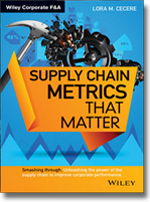Getting Inventory Right: Hope with Hype and Recycled Supply Chain Software?

I see greater value coming to clients that bypass hype and focus on business results through the implementation of best-of-breed products on the top of ERP backbones.
I am speaking this morning at the Terra Technology conference and doing a book signing of my new book, Supply Chain Metrics That Matter. It is my seventh year of speaking at this small, and intimate event.
The world of supply chain is active on my iPhone. Several good friends in consulting roles are sharing information on SAP HANA from SAP Insider; and this morning, LLamasoft announced the acquisition of the LogicTools assets from IBM.
In parallel, I have been hard at work on a report on multi-tier inventory optimization for the last two weeks. This inbound news adds to the story. It will delay my report. In this post, I want to share my reflections.
SAP: Will Hype Translate to Hope?
The news from SAP Insider is a continued drumbeat on the HANA rewrite of SAP’s supply chain applications. Excitement abounds.
My advice is for customers to not get caught up in the hype. I am actively covering several supply chain HANA implementations and they are not going so well.
Three clients in my interviews have been actively working on pilots for multiple years and are struggling with some fundamental problems. It reminds me of the development days of the CIF interface with SAP APO 3.1 when I only saw three customers successful after intense codevelopment. A hard sled…. Buyer beware.
In the research for my inventory optimization report, the lowest level of satisfaction with multi-tier inventory optimization is with clients of the SAP inventory solution (previously purchased from SmartOps). Why is this relevant? The multi-tier inventory optimization product termed MEIO is at the center of the new HANA stack for supply chain which includes demand sensing and the SAP Integrated Business Planning product. The MEIO product is a proof point in the SAP rhetoric of why SAP HANA is a good thing.
What do I hear in interviews? What do I see? In the research for the inventory optimization and the S&OP reports, I find a handful of VERY experienced SAP clients doing codevelopment with the SAP IBP product. There are issues with bottom-up and top-down demand aggregation in the SAP IBP tests along with integration with APO. Demand sensing pilots are very early in evolution, but the results are not equal to Terra Technology’s demand sensing results.
Each client in interviews speaks of active and focused work from SAP to fix the problems, and I think that SAP will work through the issues; but, the question is how long? And at what price? My advice for mainstream SAP users is to use caution. Why? The lowest satisfaction rates with inventory optimization are at the center of the SAP HANA stack and the current work on SAP IBP is still in what I consider codevelopment. While SAP will share how many licenses they have sold - 70 licenses in the fourth quarter - and it sounds impressive, use caution. Selling licenses does not translate into implemented software.
The number of implementations is a fraction of the sales, and I cannot find a successful, implemented SAP IBP or demand sensing project. My view (and John Appleby’s)? SAP Supply Chain HANA is still a work in progress. Clients complain of implementation issues, and continual upgrades. Interview excerpts are full of comments like, “After we work hard to fix a bug, I get a new upgrade and have to start all over again. I like the SAP team, and they are trying hard, but it is frustrating.”
LLamasoft: Recycled Software Assets Offering Hope?
In parallel, LLamasoft announced the acquisition of the LogicTools Supply Chain Applications Business Unit from IBM. This includes LogicNet Plus, the Inventory and Product Flow Analyst and the Transportation Analyst products, as well as the related technology and support team. LLamasoft will begin providing software maintenance, support and services to all LogicTools customers effective immediately.
These assets have gone through several acquisitions. The LogicTools product was purchased for $15 million in 2007 by ILOG. At the time, there were 200 customers. ILOG was then purchased by IBM for $340 million in 2008. The primary impetus for IBM’s purchase of ILOG was for the BAM assets; and during the period of 2008-2014, sales by IBM of the Logictools product languished.
IBM has a history of purchasing supply chain assets, and despite great press release superlatives, the company has underperformed in the building and selling of supply chain industry solutions. IBM has many legacy supply chain assets in their arsenal including the Demandtec, Emptoris, Sterling Commerce, and Yantra products; however, IBM’s presence in the supply chain market continues to wane.
Currently there are 150 customers of the LogicTools product. It has lost market luster from the days when the founder David Simchi-Levi brought it to market. The product was a no-frills reasonably-priced product, that worked. Logictools has a loyal customer base that weathered the storm of acquisitions. There is still an active core of clients that are quietly using the product.
What do I think that this means for the market? LLamasoft is moving down the stack. With a traditional focus on network design and inventory flows with their GURU product, LLamasoft is getting more serious about tactical supply chain planning.
While LLamasoft has great client references in network-design projects, the product is traditionally used on a more ad hoc basis. The company is early in building an enterprise-class solution with robust APIs and role-based security. I believe that this is a move to get more serious about inventory optimization and building enterprise-class solutions. This is good news for the both the LogicTools and the LLamasoft installed bases.
LLamsoft promises the release of new versions and updates for all three LogicTools software products this year, including the preview of LogicNetPlus Version 8 in just a few months at SummerCon in June, 2015. Don Hicks, LLamasoft’s founder, commits that LLamasoft will not be forcing clients to switch to the LLamsoft products.
My Take:
The greatest improvement in inventory and overall value in supply chains continues to come from best-in-breed solutions. While the large system integrators will push offerings from ERP Expansionists like SAP and Oracle, I see greater value coming to clients that bypass hype and focus on business results through the implementation of best-of-breed products on the top of ERP backbones.
I feel that the LLamsoft acquisition is good for the market, but I believe that the SAP HANA release is not ready for prime time. Today, the SAP HANA product is only for the early adopter with strong SAP codevelopment resources.
As you know, I am straight shooter. This is my take. I would love to hear yours. I like differing points of view…(use the “Comments” window below).

About the Author
Lora Cecere is the Founder and CEO of Supply Chain Insights, the research firm that’s paving new directions in building thought-leading supply chain research. She is also the author of the enterprise software blog Supply Chain Shaman. The blog focuses on the use of enterprise applications to drive supply chain excellence. Her book, Bricks Matter, was published in December of 2012.
Supply Chain Metrics that Matter new book
Supply Chain Management (SCM) - the combined processes of procurement (source), manufacturing (make) and logistics (deliver) - is now thirty years old. Empirically companies know that supply chain performance matters to corporate performance; however, groups argue on which metrics matter the most and why. This book answers these questions. Order Online
Article Topics
LLamasoft News & Resources
Talking Supply Chain: The Truth About Digital Twins Coupa brings LLamasoft into the fold in $1.5 billion acquisition Coupa Acquires AI-Powered Supply Chain Design & Planning Leader LLamasoft for $1.5 billion Smoother execution through S&OP A Fresh Take on Supply Chain Innovation Nine Ways Food and Beverage Companies Can Use Supply Chain Design to Drive Competitive Advantage Brexit, the Next Big Disruption for the Supply Chain? More LLamasoftLatest in Supply Chain
Spotlight Startup: Cart.com Walmart and Swisslog Expand Partnership with New Texas Facility Nissan Channels Tesla With Its Latest Manufacturing Process Taking Stock of Today’s Robotics Market and What the Future Holds U.S. Manufacturing Gains Momentum After Another Strong Month Biden Gives Samsung $6.4 Billion For Texas Semiconductor Plants Apple Overtaken as World’s Largest Phone Seller More Supply Chain















